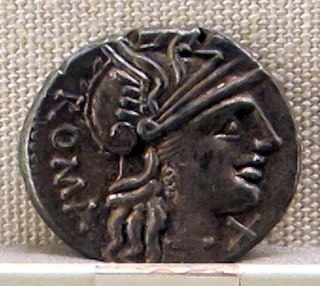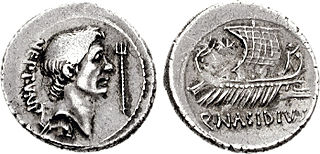Related Research Articles
The gens Baebia was a plebeian family at ancient Rome. The first member of the gens who obtained the consulship was Gnaeus Baebius Tamphilus, in 182 BC. During the later Republic, the Baebii were frequently connected with the patrician family of the Aemilii.

The gens Minucia was an ancient Roman family, which flourished from the earliest days of the Republic until imperial times. The gens was apparently of patrician origin, but was better known by its plebeian branches. The first of the Minucii to hold the consulship was Marcus Minucius Augurinus, elected consul in 497 BC.
The gens Afrania was a plebeian family at Rome, which is first mentioned in the second century BC. The first member of this gens to achieve prominence was Gaius Afranius Stellio, who became praetor in 185 BC.
The gens Alliena or Aliena was a minor plebeian family of the Roman Republic. The first member of the gens to achieve prominence was Lucius Alienus, plebeian aedile in 454 BC. However, the family then slipped into obscurity for several centuries, emerging once more in the first century BC.
The gens Caecinia was a plebeian family of Etruscan origin at ancient Rome. Members of this gens are first mentioned in the time of Cicero, and they remained prominent through the first century of the Empire, before fading into obscurity in the time of the Flavian emperors. A family of this name rose to prominence once more at the beginning of the fifth century.

The gens Pomponia was a plebeian family at ancient Rome. Its members appear throughout the history of the Roman Republic, and into imperial times. The first of the gens to achieve prominence was Marcus Pomponius, tribune of the plebs in 449 BC; the first who obtained the consulship was Manius Pomponius Matho in 233 BC.
The gens Coruncania was a plebeian family at ancient Rome. The first of the family to come to prominence was Tiberius Coruncanius, a novus homo who became consul in 280 BC, and dictator in 246.

The gens Sosia, occasionally written Sossia, was a plebeian family at ancient Rome. Members of this gens occur in history from the end of the Republic down to the third century AD. The first of the Sosii to attain the consulship was Gaius Sosius in 32 BC, and the family would continue holding various positions in the Roman state until the third century.

The gens Nasidia was an obscure plebeian family at Rome. The gens is best known from Quintus Nasidius, one of the admirals of Gnaeus Pompeius Magnus during the Civil War. Although none of the Nasidii are known to have held any of the higher offices of the Roman state, a number are known from inscriptions. A coin of this gens depicts the head of Pompeius and a trident on the obverse, and on the reverse a ship, with the inscription Q. Nasidius.
The gens Peducaea, occasionally written Paeducaea or Peducea, was a plebeian family at ancient Rome. Members of this gens occur in history from the end of the second century BC, and from then to the time of Antoninus Pius, they steadily increased in prominence. The first of the Peducaii to obtain the consulship was Titus Peducaeus in 35 BC.
The gens Plinia was a plebeian family at ancient Rome. Few members of this gens are mentioned in history, and the Plinii are best known from the scholar and antiquarian, Gaius Plinius Secundus, author of the Historia Naturalis, who lived during the first century AD.
The gens Saenia was a plebeian family at ancient Rome. Members of this gens are first mentioned in the final century of the Republic, and Lucius Saenius attained the consulship in 30 BC.
The gens Sallustia, occasionally written Salustia, was a plebeian family at ancient Rome. Members of this gens are first mentioned in the time of Cicero, and from that time they attained particular distinction as statesmen and writers. The most illustrious of the family was the historian Gaius Sallustius Crispus, who wrote valuable works on the Jugurthine War and the Conspiracy of Catiline, which still exist.
The gens Salvidiena was a plebeian family at ancient Rome. Members of this gens are first mentioned toward the end of the Republic, and from then to the end of the second century they regularly filled the highest offices of the Roman state.
The gens Carrinatia was a plebeian family at ancient Rome. Members of this gens rose to prominence during the final century of the Republic, attaining the consulship in 43 BC.
The gens Thoria was a minor plebeian family at ancient Rome. Only a few members of this gens are mentioned in history, but a number are known from inscriptions.
The gens Thorania, also written Torania, was a minor plebeian family at ancient Rome. Only a few members of this gens are mentioned in history, but others are known from inscriptions.
The gens Tillia, occasionally written Tilia, was a minor plebeian family at ancient Rome. Few members of this gens are mentioned in history, but others are known from inscriptions.
The gens Trebatia was a minor plebeian family at ancient Rome. Members of this gens are first mentioned at the time of the Social War, in which one of the Samnite generals was a Trebatius, but the best-known of the Trebatii is likely the jurist Gaius Trebatius Testa, a contemporary and friend of Cicero, Caesar, and Augustus.
The gens Turia, occasionally written Turria, was a minor plebeian family at ancient Rome. Several members of this gens are mentioned by Roman writers, although none of them ever obtained the consulship. Lucius Turius, who stood for the consulship in the late Republic, was praetor in 75 BC.